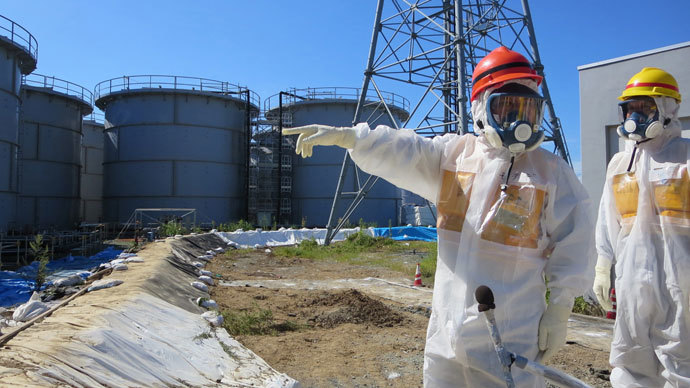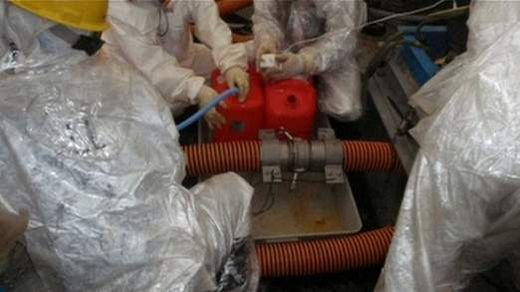
© AFP/TEPCOThis handout picture taken by Tokyo Electric Power Co. (TEPCO) on August 26, 2013.
Seawater just outside one of Japan's damaged Fukushima Daiichi reactors registered radiation levels on Wednesday 13 times the previous day's reading, the operator of the crippled nuclear plant said on Thursday.
Japan's Tokyo Electric Power Company (TEPCO), said combined Cesium-134 and Cesium-137 readings just outside the damaged No. 2 reactor jumped to 1,200 becquerels per liter on Wednesday, the highest levels recorded since late 2011.
Regulatory limits for Cesium, which emits powerful gamma radiation and is potentially fatal to humans, is 90 bq/liter for Cesium-137 and 60 bq/liter for Cesium-134.
A TEPCO spokesman said the sudden spike in radiation was caused by construction work near the No. 2 building, Reuters reported.
News of the spike in radiation levels is the latest setback this week for TEPCO, which has been harshly criticized for its handling of the nuclear disaster in the wake of the massive quake and tsunami that hit the power station in March 2011, triggering three reactor meltdowns.
On Wednesday, six workers were exposed to radiation after a pipe connected to a contaminated water treatment system was mistakenly detached. Reuters estimates that at least 7 tons of water escaped the system.
Earlier, a worker accidentally switched off a water pump used to channel water into the reactor building.
Crews are using chemicals to fortify the soil around the Fukushima reactor buildings - hundreds of meters from the port entrance that connects to the Pacific Ocean - to prevent contaminated water from flowing into the ocean. The pressure from injecting chemicals into the ground forced contaminated soil out into the port area, the spokesman said.
TEPCO also said Cesium-137 readings just outside the silt fence next to the No.2 reactor increased to160 bq/liter, a number that exceeds the regulatory limit and almost double the previous day's reading.
Radiation from radioactive water leaking from the plant is mostly confined to the harbor around the facility, officials have said.
TEPCO, which is using hundreds of tons of water in an effort to keep the reactors from overheating, has struggled to contain the buildup of radioactive water at the plant.
The accidents at the Fukushima Daiichi plant, situated 220 km (130 miles) from Tokyo, are fueling doubts over TEPCO's abilities to oversee a hugely complicated cleanup that is expected to take decades.
Last week, the beleaguered Japanese energy company said 430 liters (113 gallons) of contaminated water had leaked from a storage tank at Fukushima and probably flowed to the ocean.
Meanwhile, Japanese officials have said there is no environmental threat to other countries as radiation will be diluted by the sea.
Tokyo, despite lingering concerns over the long-term safety situation at Fukushima, was selected last month to host the 2020 Olympic Games.
- RT
© Sky NewsWorkers in protective suits examine the pipes where the leak occurred.
: Six workers at Japan's crippled Fukushima nuclear plant have been doused with highly radioactive water after wrongly disconnecting a pipe.
The accident sent toxic water spilling on to them and the entire floor of the facility which houses a set of three units designed for water treatment.
The workers were wearing face masks with filters, protective hazmat suits and raingear, and their exposure is believed minor but still under investigation, said Yoshimi Hitosugi, spokesman for operator Tokyo Electric Power Co (Tepco).
The workers were part of an 11-member team, and the remaining five were not splashed, he said. They managed to reattach the pipe later.
The accident is latest in a string of mishaps. A week earlier, workers overfilled a storage tank without fully checking water levels, and caused a leak of 430 litres (113 gallons) of contaminated water which is thought to have run into the sea.
Tepco has been battling to contain radioactive water since the plant suffered triple meltdowns and hydrogen explosions following a devastating earthquake and tsunami in March 2011.
In the latest incident, the company said a worker mistakenly detached a pipe connected to a treatment system which removes salt from the hundreds of tonnes of cooling water Tepco pumps over the melted fuel in wrecked reactors.
Tepco said seven tonnes of water were spilled in Wednesday's incident but was contained within the site.
[...]
The accidents at the Fukushima Daiichi plant, 130 miles (220 kilometres) north of Tokyo, are adding to a crisis no one seems to know how to contain, and stirring doubt over Tepco's abilities to carry out a complex cleanup widely expected to take decades. -
Sky News
how can they just mistake the pipe/valve with such serious consequences, it's like Laurel and Hardy are working there. What happens when they try and empty the fuel pool of it's rods is a nightmare. Arnie Gundersen said in a normal undamaged event the crane is computer controlled to tolerences of within 2-3mm. It seems the cranes to be used are the ordinary building/engineering type swaying in the winds and operated remotely due to the high radiation levels; drone cranes. I wish them luck.
This article is by a yachtsman recently repeating a voyage from Japan to the USA he'd undertaken some years earlier......he says 'The ocean is broken'. [Link]